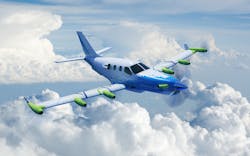The EcoPulse hybrid aircraft passes Preliminary Design Review
TOULOUSE, France - The EcoPulse distributed propulsion hybrid aircraft demonstrator – which is being developed by Daher, Safran and Airbus with the support of France’s CORAC civil aviation research council – has successfully passed its Preliminary Design Review as a first key step toward validating the project’s feasibility and firming up the architecture for a first flight scheduled in 2022.
Incorporating a distributed propulsion configuration from Daher, Safran and Airbus, this shared hybrid aircraft project has the goal of helping to transform the aviation sector. EcoPulse, which was unveiled at the 2019 Paris Air Show, is backed by the French government – with a reaffirmation of support coming in the framework of France’s recovery plan presented last June.
By laying the framework for light aircraft by the end of the decade, it will allow the development of technologies that reduce the environmental footprint of future commercial aircraft, thus contributing to the air transportation sector’s decarbonization objectives by 2050.
After more than one year of development based on a light aircraft platform supplied by Daher, the project has reached a key milestone with the successful completion of its Preliminary Design Review (PDR), which enabled the validation and freezing of the demonstrator’s baseline configuration, as well as confirming the hybrid distributed propulsion system’s level of safety and compatibility with the aircraft.
The project is now entering the assembly and integration phase at Daher, with systems supplied by Safran and Airbus.
Safran, which is responsible for EcoPulse’s distributed hybrid-electric propulsion system, has finalized the technical configuration of its six electric thrusters. They will be fitted with 50 kW ENGINeUS electric motors with integrated electronics and patented air cooling, as well as propellers supplied by DUC Hélices. The Safran ENGINeUS motor will be submitted for EASA certification – the same type as granted for a turboshaft engine.
Also validated by Safran are the installation interfaces for the propulsion system’s other components, along with the power management system, the turbogenerator and the high-voltage wiring that will supply electrical power to the thrusters. The turbogenerator, which performed its first test bench runs in 2018, will soon undergo additional tests.
The next step for Safran will be its delivery of an initial electric thruster to Airbus for wind tunnel and endurance testing, in preparation for qualification of the thrusters’ use on EcoPulse's first flight.
